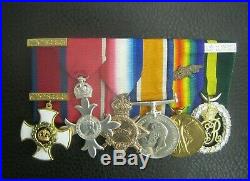
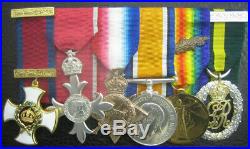
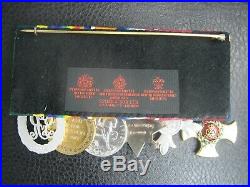
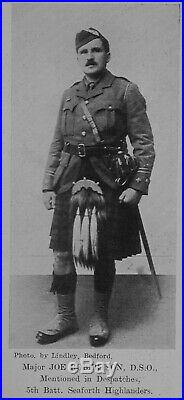
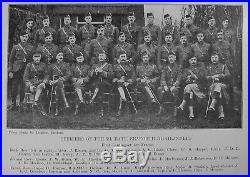
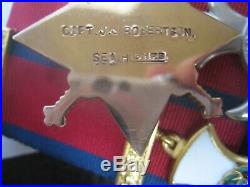

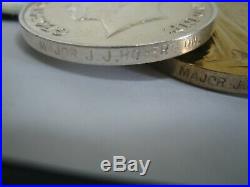
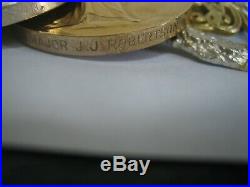
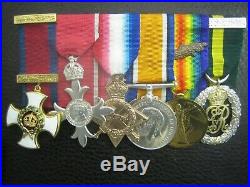
A FINE GREAT WAR 1916 CAPTURE OF BEAUMONT-HAMEL D. GROUP AWARDED TO A SEAFORTH HIGHLANDERS COLONEL, WHO WAS WOUNDED WHILE LEADING HIS COMPANY AT FESTUBERT IN JUNE 1915 AND FURTHER DECORATED FOR HIS GALLANT COMMAND OF THE 5TH BATTALION IN THEIR SUCCESSFUL ASSAULT ON A STRONGHOLD PREVIOUSLY REGARDED, BY BOTH BRITISH AND GERMANS ALIKE, TO BE IMPREGNABLE. HE WAS ADDITIONALLY TWICE M. DISTINGUISHED SERVICE ORDER, G. SILVER-GILT AND ENAMEL, WITH INTEGRAL TOP RIBAND BAR, THE MOST EXCELLENT ORDER OF THE BRITISH EMPIRE, M. (CIVIL) MEMBERS 2ND TYPE BREAST BADGE, SILVER; 1914-15 STAR CAPT. HIGHRS; BRITISH WAR AND VICTORY MEDALS, WITH M. OAK LEAVES MAJOR J. ROBERTSON; TERRITORIAL DECORATION, G. SILVER AND SILVER-GILT, HALLMARKS FOR LONDON 1918, WITH INTEGRAL TOP RIBBON BAR. London Gazette 10 January 1917. The original recommendation states. For conspicuous gallantry in action. He reorganised several small parties under heavy fire, and drove off an enemy attack. He formed with 20 men a strong post in the enemys second line. Later, he led the men forward again and consolidated an advanced defensive line. He set a splendid example throughout. London Gazette 1 January 1954 M. London Gazette 15 June 1916 and 25 May 1917 Josiah James Robertson was born in 1879 at Wick. Having joined as a Private some six years earlier, he was commissioned Second Lieutenant in the 1st Sutherland (The Sutherland Highland) Volunteer Rifle Corps on 17 October 1903 and promoted Lieutenant on 20 December 1905. Following the re-designation of the Battalion as the 5th (Sutherland & Caithness Highland) Battalion, Seaforth Highlanders in 1908, he was promoted Captain in November 1912 and during the Great War he proceeded to. With them on 1 May 1915 as part of 152nd Brigade of the 51st Highland Division. Robertson was wounded leading C Company of the 5th Seaforth Highlanders in their attack on the German salient at Festubert on 15 June 1915. His company, which was first over the parapet and led the battalion, consequently suffered the brunt of the casualties. The following extracts from a letter written by a platoon sergeant serving with C Company, and published in The History of the 51st. Division by Major F. Bewsher, describe the bloody assault. On the 15th we had a most uncomfortable day. The Boche rose early, having apparently known our plans. In fact, some of them were heard to call across No Mans Land, Come along, Jocks; we are waiting for you. And undoubtedly they were. From early morning we were subjected to continuous shell-fire, causing many casualties to us. As the afternoon drew on the Boche became still more lively, but we still had great hopes. These, however, became fainter as each occasional look over the top showed the German wire unbroken.. Our time had now come. Nothing for it but to go over. The order was passed along, Get ready. At 6.45pm the order came Advance! The place was a perfect hell. Just one solid sheet of bullets. Many were hit on the top of the parapet; before a distance of thirty yards was traversed all the officers of our company were hit, as well as the brigade bombing officer (Lieutenants Mowatt and Dunnet killed, Captains Robertson, Ritson, and Lieutenant Fraser-Campbell wounded). On we went; but men were falling in all directions, and by the time we were within reach of the German wire, not more than fifteen of the company were still on the move. The outlook was hopeless, the wire was an insurmountable obstacle, and the few who remained had to take cover in the nearest shell-hole until darkness allowed us to make our own lines again – a sad dejected remnant of a company. According to the War diary of the Fifth Seaforth Highlanders by Capt D. The Fifth Seaforths suffered heavily in proportion to the numbers actually involved in the advance. “C” Company was the first to top the parapet, and this they did in gallant style, advancing under a murderous tire in open order as steadily as if on parade. They were horrified to find that on their front the German wire was absolutely intact, and ail the survivors could do was to take advantage of any depression in the ground and wait for night. At 4.30 a. A second attack was ordered, but, news having arrived that the 153rd and 154th Brigades had had to retire, the order was countermanded. On taking the toll of battle, it was found that Lieuts. Dunnet were killed, and Captains Robertson and Ritson and Lieutenants W. Wounded, while 32 men were killed and 70 wounded. Three days later Captain Robertson was evacuated to. Rejoining the 5th Seaforths on 11 June 1916. Unquestionably for his gallantry at Festubert, was gazetted later the same week. The battalion would then fight the following month at the. There, at High Wood and Mametz Wood, the 5th Seaforths alone had about 225 casualties in little over a fortnight. Robertson was awarded the D. For conspicuous gallantry at the capture of Beaumont Hamel during the. Of the Ancre on 13 November 1916. Here, the 51st Highland Division, including the 5th Seaforths led by Robertson, succeeded in dislodging the Germans from a position previously regarded, by British and Germans alike, as almost impregnable. Colonel John Sym in his 1962 account The Seaforth Highlanders, takes up the story, giving specific mention of Robertsons deeds. The 5th Seaforth had the honour of leading the attack, on one sector of the village, with their left flank on the Auchonvillers-Beaumont Hamel Road; their final objective being a German trench line 200 yards east of the village. The enemys machine-gun fire and uncut wire in the centre, held up the advance for a time, so that the barrage went too far ahead while, owing to dense fog, direction was lost and the attack split up into small parties. Yet in spite of these difficulties, the first German line was easily carried, except for one or two isolated points where the enemy put up a good fight. Dropping into the trench, sentries were posted at the dug-out doors, while a few bombs were sent down as a gentle reminder of our presence. The first wave held this trench, and arranged for disposal of prisoners, etc. While the second, third, and fourth waves passed on to the succeeding trenches. The second line was also soon captured but, for the third line, the fighting was more stubborn; a machine-gun post and some snipers effectually sweeping the ground of our advance. Two bombing parties were hurriedly formed, and advanced along the trenches, killed the machine gunners and captured their guns. To get these and the snipers, a party had to enter and pass through a dug-out, and climb a stair, into a concrete apertured little fort, the holders of which were thoroughly surprised at their secret entrance having been discovered. In the afternoon the Battalion, which by that time consisted of just 90 men under Major Robertson, with Captains Morrison and Murray and 2/Lieutenants Lupton and Mackay, went through Beaumont-Hamel and consolidated the final objective as arranged. By 4pm the Division had gained its objective and the complete defensive system was in our hands, while over 1700 prisoners, of whom the 5th Seaforth claimed 600, had been sent to the rear. The Battalion remained in the line until the night of 14/15th November, and during these two days, the casualties were: 94 killed or died of wounds; 193 wounded and 5 missing, including 2/Lieutenants Angus Mackay and B. Holroyd, killed and 9 Officers wounded. Major Robertson, as senior Officer in the advance, displayed great coolness, working out the proper line of advance by compass, when sense of direction was lost owing to the fog. He collected the scattered parties under heavy fire and, when attacked by an enemy bombing party, he drove them off and finally led his men to the fourth line, which he consolidated and held. In this battle, the Battalion earned high praise for its fighting qualities; the Corps Commander, writing to the Division after the battle said, All the world looks upon the capture of Beaumont-Hamel as one of the greatest feats of the war, and to those who know the ground and defences, it must always be a marvellously fine performance. Among the honours awarded were the Distinguished Service Order to Major J. Robertson, Military Crosses to 2/Lieutenants Lupton and A. Mackay, a Military Medal Second Award Bar to Company Sergeant-Major Goddard, and 10 Military Medals. Robertson received his second Mention in Field Marshal Haigs despatch of 9 April 1917, almost certainly also as a result of the action at Beaumont-Hamel. After the Great War he commanded the 4/5th Seaforth Highlanders T. From 1924 to 1928 and was promoted Brevet Colonel in 1928. From 1919 until 1954 he was a member of the Northern War Pensions Committee being Chairman for the last five years and he was awarded the M. In 1954 for this work. The Colonel died at his home. In Wick in 1966 aged 88. Condition, very minor contact marks, otherwise NEF. SEE MY OTHER AUCTIONS FOR MORE WW1 GALLANTRY AWARDS. This will generally be a Wednesday or Thursday, so please bear with me if it takes a few more days to get sent. KEYWORDS: MEDAL MEDALS BOER KILLED WOUNDED BRIGADE AWARD CAPTAIN COMMANDER LIEUTENANT OFFICER KILLED WOUNDED 1815 AUSTRALIAN NEW ZEALAND ANZAC AIF GALLANTRY SOMME YPRES GALLIPOLI LIGHT HORSE INFANTRY BATTALION WW1 WW2 GALLANTRY. The item “WW1 SEAFORTH HIGHLANDERS COLONEL’S DSO, MBE, MID MEDAL GROUP” is in sale since Saturday, June 13, 2020. This item is in the category “Collectables\Militaria\World War I (1914-1918)\Medals/ Ribbons”. The seller is “albatrosj1″ and is located in SCOTLAND. This item can be shipped worldwide.